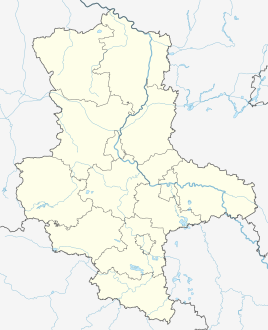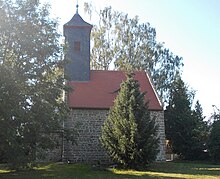Nißma
|
Nißma
Municipality Elsteraue
Coordinates: 51 ° 1 ′ 6 ″ N , 12 ° 16 ′ 48 ″ E
|
||
|---|---|---|
| Residents : | 280 (2008) | |
| Incorporation : | July 1, 1950 | |
| Incorporated into: | Spora | |
| Postal code : | 06729 | |
| Area code : | 03448 | |
|
Location of Nißma in Saxony-Anhalt |
||
Nißma is a district of the locality Spora within the municipality Elsteraue in the Burgenlandkreis in the south of Saxony-Anhalt .
geography
The area of the village Spora, to which Nißma belongs, is located in the eastern tip of the Burgenlandkreis southwest of the Thuringian city of Meuselwitz . The Nißmaer Graben flows through the village and flows into the Schnauder . Nißma is part of the Meuselwitz-Altenburger lignite district , which in turn belongs to the Central German lignite district. The place lies on the border to the Thuringian Altenburger Land .
history
The area of today's Spora has belonged to the Zeitz diocese since 986 . Nißma was first mentioned in 1154 as "Nizmene". The place was in the Zeitz office until 1815 , which as part of the Naumburg-Zeitz bishopric had been under Electoral Saxon sovereignty from 1561 and belonged to the secondary school- principality of Saxony-Zeitz between 1656/57 and 1718 . By the resolutions of the Vienna Congress Nißma came with the Office Zeitz in 1815 to Prussia and in 1816 the county Zeitz in the administrative district of Merseburg of the Province of Saxony allocated.
In the 19th century, lignite mining in the Spora area gained great importance. The area was the westernmost branch of the Meuselwitz-Altenburg lignite mining area . The Nißmaer mine was opened in 1868. After coal mining in the Spora area ended in the first half of the 20th century, the remaining open pit holes north of Nißma were flooded. In the 1980s, the resumption of lignite mining was planned, but this was not carried out. A large part of the Spora location should have given way to the planned “Spora opencast mine” between Oelsen and Nißma. The “Meuselwitz opencast mine” was planned to the east and north of Nißma.
From June 1944 until the occupation of the region by US troops in mid-April 1945, there was an anti-aircraft position with 24 guns 8.8 cm, 3 guns 3.7 cm and 9 guns 2 cm at the height between Nißma and Neuposa . It was a so-called large battle battery.
On February 20, 1945 Nißma experienced a night air raid by the British Royal Air Force . A carpet of bombs with bombs and air mines, probably intended for the flak battery, hit the neighboring hallway and reached into the center of Nißma. 5 houses were totally destroyed, 22 seriously and 61 slightly damaged. 22 people died, including 7 children. The neighboring towns helped with the rescue and extinguishing work. Most of the victims were buried in the Nißma cemetery, some in Meuselwitz. Based on the experience of this attack, an air raid shelter was built in the village.
From April 1945, the whole area suffered from low-level aircraft attacks . The anti-aircraft guns were set up for ground combat, some withdrawn to other defensive positions. On April 13th there was a tank alarm, fighting followed and the occupation of the place and the flak position by the US Army.
At the beginning of July Nißma, like all of Thuringia, was passed on by the Americans to the Red Army . This made it part of the Soviet Zone and, from 1949, of the GDR .
On July 1, 1950, Nißma was incorporated into Spora together with Prehlitz-Penkwitz and Oelsen. In the course of the second district reform in the GDR, Spora and its districts came to the Zeitz district in the Halle district in 1952, which became the Zeitz district again in 1990 and was incorporated into the Burgenland district in 1994. On July 1, 2003, Spora merged with eight other previously independent municipalities to form the Elsteraue municipality. Since then Nißma has been part of the Spora village within the Elsteraue community.
Culture
A major event in recent history for the village was the 850th anniversary celebration in 2004.
In 2008, after a short construction period, the more than 850-year-old church was consecrated again in the presence of the Protestant regional bishop Axel Noack . This small Romanesque hall church dates from the 12th century. It has a retracted apse and an eastern roof tower from the 17th / 18th centuries. Century adorned. The portal that is now walled up was originally on the south side. Inside there are two epitaphs from the 18th century.
In the cemetery, next to the church, as a war cemetery (signposted in the village), there is a well-tended community grave with 13 German soldiers (shared name plaque) who died on April 15, 1945. They are defenders of the Nißma flak position. On photos from 2003 you can still see individual German grave crosses and a memorial for Italian military internees who died near Nißma . No memorial stone commemorates the civilian victims of the bombing of February 20, 1945.
societies
In Nißma is the venue for the soccer players of SV Spora. The sports field is located in the center of the village.
Web links
literature
- Volker Thurm: The flak position Nissma , 1st and 2nd part. Kayna, 2013
Individual evidence
- ^ Karlheinz Blaschke , Uwe Ulrich Jäschke : Kursächsischer Ämteratlas. Leipzig 2009, ISBN 978-3-937386-14-0 , pp. 84 f.
- ^ The Zeitz district in the municipal directory 1900
- ↑ The Altenburg / Meuselwitz lignite district, LMBV publication
- ↑ Volker Thurm: The flak position Nissma , 2nd part. Kayna, 2013. p. 21 ff
- ^ StBA: Changes in the municipalities in Germany, see 2003
- ↑ Jürgen Möller: The fight for Zeitz April 1945 . Rockstuhl Publishing House, Bad Langensalza 2010. p. 222


